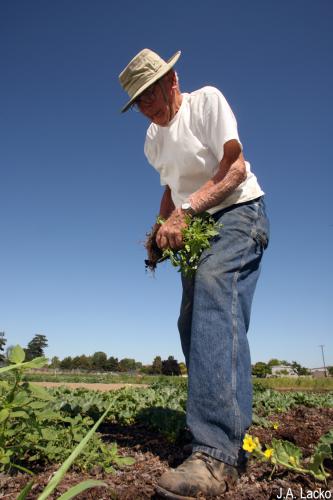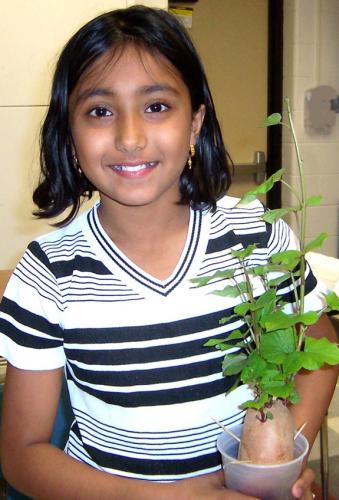
How to plan your garden tip sheet
DOWNLOADAugust 26, 2016
No one is likely to eat better than the home gardener who has a well planned and tended garden. The home gardener can grow fresher vegetables those bought them at the store and grow favorite varieties that are not readily available for purchase. It’s not hard to be successful if you know how to get started.
Where to put your garden
For gardening success, it is important to consider the following when picking a location for your garden:
Locate the garden near a water source. Sometimes rainfall alone is not adequate for your vegetable plants. You will need to add additional water, and a close water source makes it much easier to provide necessary water without much effort.
The garden should also be convenient to your home. It is easier to remember to harvest your crops and tend your garden if you have easy access. A location that you can see from the kitchen will provide a visual reminder to regularly visit the garden.
A sunny, level spot that receives six to eight hours of direct sunlight during the day is essential. The location should not be near trees and shrubs whose roots will compete for nutrients and moisture in the soil, as well as shade your garden. Avoid north-facing slopes because these will be colder and shaded. Low areas will also be colder and the soil may stay too wet for extended periods, causing rot and disease problems.
The soil should be loose when you pick it up in your hand, free from toxins, and tested for pH and nutrient availability. The best time to test and prepare the garden soil is in fall. The second best time is in spring, a couple weeks before you plan to plant the garden. Some gardeners add organic matter (compost or peat moss) to improve water drainage in the soil.
 Arranging your garden
Arranging your garden
After choosing a site, the next step is to plan the arrangement of crops in the garden. Consider each of these points carefully.
Garden size
Your garden’s size depends on space available, quantity of vegetables, kind of vegetables, and the amount of work and time you plan to devote to the garden. Make the garden just large enough to grow the plants you want, but not so large that it will become a burden and not receive proper care. It is much better to start small; the garden can be enlarged in subsequent years.
Choosing vegetables to plant
Choose vegetables that you and your family enjoy. Beginners should start with easy-to-grow varieties such as tomatoes, zucchini, squash, sweet corn and beans. If your garden plot is small, grow mostly crops with a freshness not generally found in stores. These include: asparagus, beans, broccoli, leaf lettuce, peas, radishes, spinach, sweet corn and tomatoes. Plant what you will eat, but think about trying one new vegetable each year.
Some vegetables take up more space, so they should seldom be grown in small gardens (25 feet by 25 feet or smaller). These include: peas, cucumbers, melons, corn, cabbage, broccoli, cauliflower, potatoes, and squash (vine type).
If a small area is available for the garden, grow crops that are especially productive such as snap beans, tomatoes, radish, lettuce, turnip, onions, greens, carrots and peppers. If you plan to grow tomatoes, it is important to stake or cage these plants to conserve space, make harvesting easier and reduce disease and insect problems.
How much to plant
The amount of each vegetable grown will depend upon the needs and desires of your family. To help plan an adequate amount, refer to the planting chart.
Seeds or tranplants?
Cool season crops, such as lettuce, spinach, radishes, broccoli and cauliflower, may be grown easily from seeds in both spring and fall. Warm season crops, such as tomatoes and peppers, take longer to mature so you may want to purchase transplants or start seeds indoors in early spring, approximately six weeks before planting.
Garden layout
Various vegetables should be grouped in your garden layout according to their growing season requirements and growth characteristics. Plant perennial crops, such as rhubarb and asparagus, along one side of the garden, so they will not be disturbed when you till the soil. Group early planted crops together and wherever possible, plant tall growing crops to the north or west of lower growing crops to avoid shading.
Draw a diagram of the garden site on graph paper. Include the kinds and amounts of vegetables you will plant, the distance between rows and between plants within a row, and the proper time to plant. Remember a north to south layout is ideal for the rows in your garden, if possible. Graph paper is an excellent tool for drawing your diagram.
A garden diary is a useful for gardeners. Include the varieties to be planted, planting dates, estimated time to harvest, problems encountered and how you solved them, and quality and quantity of each harvest. These records will help you plan your garden in future years. You may write this information on a calendar or type it into your electronic planner; this way you will have yearly records.
Make the most of your space
Select smaller varieties of vegetables such as patio tomatoes or bush varieties of beans, cucumbers, or melons. Read the back of the seed package to see how much space or area each plant needs.
Another option for gaining space is to grow crops in containers or raised beds. Spacing between plants is reduced in these situations, and walkways are not needed between rows.
Fences can allow you to save garden space by growing vegetables vertically. This works well for peas, cucumbers, squash, and pole beans.
Spacing between rows
Proper spacing between rows is important to allow for growth of plants, ease of cultivation, and efficient use of space. Recommended spacing is given on the seed package; this may help you decide just how much space you will need. Allow enough space between rows for convenient cultivation and access.
Crop rotation
To help prevent common plant diseases that overwinter in soil, it is important not to grow the same crop in the same place each year. In a smaller garden, crops may be rotated from one side of the garden to the other.

Cross-pollination
Gardeners need not be concerned about “crossing” between crops if they do not save their own seed. Many closely related vegetables will cross-pollinate (summer squash and pumpkins), but the effect is only on the seed and not on the fruit. So, you can safely plant melons beside cucumbers, red tomatoes next to yellow ones, for example.
The single exception is sweet corn. Cross pollination in this crop will influence the color, shape and flavor of the kernels.
Supply list
Prepare a list of the supplies that you will need for your garden. This may include:
- Hoses
- Sprinklers
- Garden tools
- Seeds and transplants
- Fertilizer
- Staking materials
- Mulch
- Protection from wildlife



 Print
Print Email
Email




